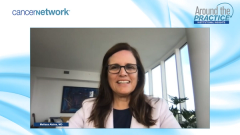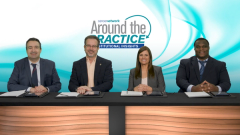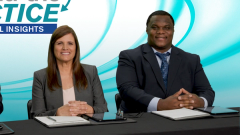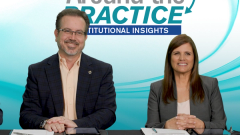
Patient Profile 3: Patient With MM Progressing After Several Prior Therapies
Centering discussion on a patient scenario of multiply relapsed multiple myeloma, panelists consider use of CAR T-cell therapy or bispecifics in this setting.
Episodes in this series

Transcript:
Melissa Alsina, MD: We’ve covered all the immunotherapy agents, including those already available and some that are in clinical trials. Perhaps we can discuss our case and then have a little more input on how to and when to offer these agents. Do you want to present this case, Brandon?
Brandon Blue, MD: Sure. We have a 59-year-old man with relapsed/refractory IgA kappa multiple myeloma who came in with a right hip fracture. He has a deletion 17p. Initial therapy was lenalidomide, bortezomib,and dexamethasone followed by lenalidomide maintenance. The patient unfortunately had refractory disease with multiple lines of treatment. The patient had DRVd [daratumumab, lenalidomide, bortezomib, dexamethasone], KRd [carfilzomib, lenalidomide, dexamethasone], KPd [carfilzomib, pomalidomide, dexamethasone] and isatuximab, pomalidomide, and dexamethasone.
We see that the patient may be eligible for bispecific T-cell engagers, and that’s where the discussion is. We’ve given what we call triple-class refractory: the main IMiDs [immunomodulatory imide drugs], the main proteasome inhibitor, and the main monoclonal antibodies. In this case, the patient got both daratumumab and teclistamab, so what do you do now? In my point of view, this patient is young—59 is about 10 years younger than the average age that someone gets newly diagnosed. We have someone with multiple refractory lines of treatment who, unfortunately, is ready for advanced myeloma treatment. That’s thought No. 1.
Thought No. 2 is that typically, the biology of the disease can help dictate you. Unfortunately, this patient has a high-risk feature with the 17p deletion, so his durational response to multiple lines of therapy was likely very truncated. If this young individual is brought to me and still has a reasonable performance status, this may be a patient I’d consider for CAR [chimeric antigen receptor] T-cell [therapy]. This may be an individual who, unfortunately, is progressing through multiple lines of therapy. But we have a therapy that’s completely novel, and it’s a different mechanism of action that he hasn’t seen before. There are no prior BCMA treatments that we’ve seen before, but this would be a targeted area and something I’d consider doing. I’d love to hear other thoughts on how you would treat this patient; that’s what I would do. This patient would be perfect for CAR T.
Ken Shain, MD: The way you left this case gives you lots of things to think about. You’ve heard us talking about CAR T vs bispecific, and there are other things that this patient hasn’t seen. If this is my patient, I’ve already thought about CAR T 2 lines ago. Something I want to make sure you think about in the community is that CAR T isn’t 1 and done. Get your patients into centers that do CAR T early. Don’t wait till their fourth line of therapy, because then you’ve got to think hard and there won’t be a lot of options. They’re going to hold patients long enough to get them through the wait list and bridge that. For trials that there are 3 or more lines, and commercials that are 4 or more lines, we want to get patients in there sooner, on the list and into CAR T slots sooner. [That way, they can get it] when it becomes available and when it’s appropriate for them.
The other part is…that CAR T is where we’d all probably start as our thought process for this individual—or anybody, because our data says octogenarians are OK for CAR T. But what’s the relapse going to look like? Can we wait, and when they’re on the CAR T list and they have time, we can bridge them with something? Or do we need to think about off the shelf? [For example] we need to give teclistamab right now because those are things we need to think about. The biology of the relapse is going to help us dictate what options we might have, whether it’s CAR T or not. That’s the point I wanted to make.
Rachid Baz, MD: I agree. This patient is likely a good CAR T candidate. I haven’t heard anything to the contrary. You could bridge with alkylating agents, but this patient has never been exposed to them from the looks of it.
Ken Shain, MD: Or celecoxib.
Rachid Baz, MD: Or celecoxib, but that could be an option for bridging. Depending on how fast the relapse is, bridging likely could be successful. If we think the patients are not likely to respond to bridging, then a bispecific would be a very good option for the patient.
Melissa Alsina, MD: I agree with everyone. If this is a patient for whom I can do CAR T immediately, then that’s my first choice. This patient hasn’t seen cyclophosphamide, for example. Cyclophosphamide in combination with carfilzomib would be a good approach. When patients are rapidly progressing with disease with no low counts or packed marrow, we consider cytotoxic chemotherapy. That is very effective and well tolerated, even though it has risk of cytopenia and infection. Then I’d try to move the patient to CAR T. This patient has high-risk myeloma with 17p, which unfortunately is still a challenge. This is a group of patients who are still difficult to treat, but CAR T is the best option. If there’s a study using something for maintenance after CAR T, that would be probably my treatment of choice.
Transcript edited for clarity.
Newsletter
Stay up to date on recent advances in the multidisciplinary approach to cancer.



























































































